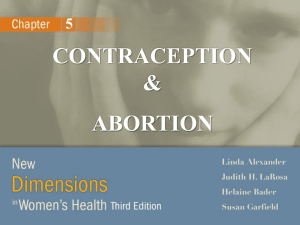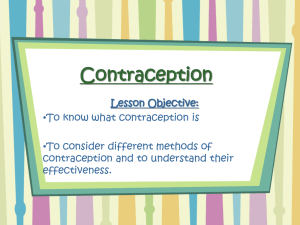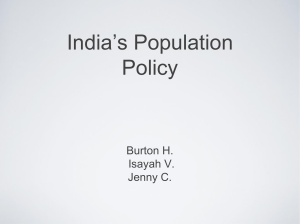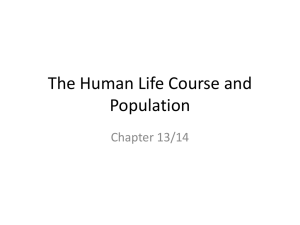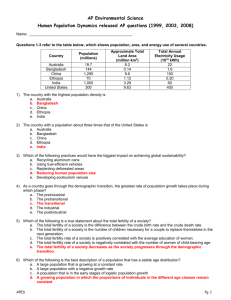Syllabus - The Bixby Center for Population, Health, and Sustainability
advertisement
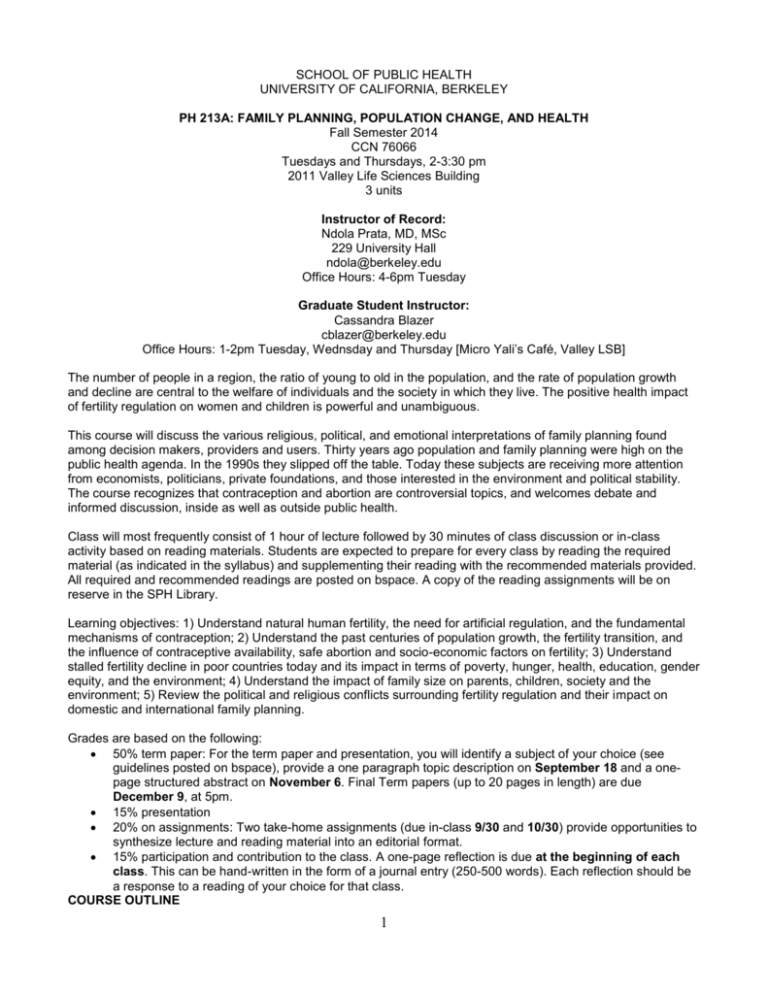
SCHOOL OF PUBLIC HEALTH UNIVERSITY OF CALIFORNIA, BERKELEY PH 213A: FAMILY PLANNING, POPULATION CHANGE, AND HEALTH Fall Semester 2014 CCN 76066 Tuesdays and Thursdays, 2-3:30 pm 2011 Valley Life Sciences Building 3 units Instructor of Record: Ndola Prata, MD, MSc 229 University Hall ndola@berkeley.edu Office Hours: 4-6pm Tuesday Graduate Student Instructor: Cassandra Blazer cblazer@berkeley.edu Office Hours: 1-2pm Tuesday, Wednsday and Thursday [Micro Yali’s Café, Valley LSB] The number of people in a region, the ratio of young to old in the population, and the rate of population growth and decline are central to the welfare of individuals and the society in which they live. The positive health impact of fertility regulation on women and children is powerful and unambiguous. This course will discuss the various religious, political, and emotional interpretations of family planning found among decision makers, providers and users. Thirty years ago population and family planning were high on the public health agenda. In the 1990s they slipped off the table. Today these subjects are receiving more attention from economists, politicians, private foundations, and those interested in the environment and political stability. The course recognizes that contraception and abortion are controversial topics, and welcomes debate and informed discussion, inside as well as outside public health. Class will most frequently consist of 1 hour of lecture followed by 30 minutes of class discussion or in-class activity based on reading materials. Students are expected to prepare for every class by reading the required material (as indicated in the syllabus) and supplementing their reading with the recommended materials provided. All required and recommended readings are posted on bspace. A copy of the reading assignments will be on reserve in the SPH Library. Learning objectives: 1) Understand natural human fertility, the need for artificial regulation, and the fundamental mechanisms of contraception; 2) Understand the past centuries of population growth, the fertility transition, and the influence of contraceptive availability, safe abortion and socio-economic factors on fertility; 3) Understand stalled fertility decline in poor countries today and its impact in terms of poverty, hunger, health, education, gender equity, and the environment; 4) Understand the impact of family size on parents, children, society and the environment; 5) Review the political and religious conflicts surrounding fertility regulation and their impact on domestic and international family planning. Grades are based on the following: 50% term paper: For the term paper and presentation, you will identify a subject of your choice (see guidelines posted on bspace), provide a one paragraph topic description on September 18 and a onepage structured abstract on November 6. Final Term papers (up to 20 pages in length) are due December 9, at 5pm. 15% presentation 20% on assignments: Two take-home assignments (due in-class 9/30 and 10/30) provide opportunities to synthesize lecture and reading material into an editorial format. 15% participation and contribution to the class. A one-page reflection is due at the beginning of each class. This can be hand-written in the form of a journal entry (250-500 words). Each reflection should be a response to a reading of your choice for that class. COURSE OUTLINE 1 1. 8/28 Introduction (Prata, Potts, Blazer) Class discussion. What do you know? What can we share? What do you want? What readings do you need? Review of course outline. 2. 9/2 History of family planning (Potts) The Judeo-Christian tradition. The rise of clinics, Margaret Sanger, Marie Stopes, Comstock. Required Reading: 1. Potts and Campbell, History of Contraception, Gynecology and Obstetrics, 2002. Recommended Reading: 1. Roudi-Fahimi, F. Islam and Family Planning. Population Reference Bureau, 2004. 3. 9/4 The politics of population (Joe Speidel) Required Reading: 1. Gillespie D. Whatever happened to family planning, and for that matter reproductive health? Int Fam Plan Perspect. 2004:30(1): 34- 38. 4. 9/9 Fertility and demographic transition (Prata) Natural fertility. The proximal determinants of family size including the role of breastfeeding. Demographic theory and the role and evidence of fertility transition. The role of family planning in fertility decline. In Class Activity: Understanding demographic characteristics, indicators, and Population Pyramids in the developed and developing world. Required Readings: 1. Bongaarts J, Watkins S. Social Interactions and Contemporary Fertility Transitions. Popul Dev Rev. 1996;22(4):639–682. 2. Mazharul Islam M, Ataharul Islam M, Chakroborty N. Fertility Transition in Bangladesh: Understanding the Role of the Proximate Determinants. J. Biosoc. Sci. 1999;36(3):351–369. 3. Campbell MM, Prata N, Potts M. The impact of freedom on fertility decline. J Fam Plann Reprod Health Care. 2013;39(1):44–50. Recommended Readings: 1. Cleland J, Ali MM. Reproductive Consequences of Contraceptive Failure in 19 Developing Countries. Obstet Gynecol. 2004;104(2):314–320. 2. Bongaarts J, Casterline J. Fertility Transition: Is sub-Saharan Africa Different? Popul Dev Rev. 2013;38:153–16. 5. 9/11 Family planning programs (Prata) Rationale for family planning programs. Demographic impact; Importance for contraceptive prevalence and fertility. Controversial issues. Lessons learned. Required Readings: 1. Thomas TN, Gausman J, Lattof SR, Wegner MN, Kearns AD, Langer A. Improved maternal health since the ICPD: 20 years of progress.Contraception. 2014 Jun 21. 2. The Global Family Planning Revolution: Three Decades of Population Policies and Programs. Chapter 1: Overview and Perspective. The World Bank, 1818 H Street NW, Washington, DC. 2007. 3. Bongaarts J, Sindig S. A Response to Critics of Family Planning Programs. Int Perspect Reprod Health. 2009;35(1):39-44. 4. Cleland J, Bernstein S, Ezeh A, et al. Family planning: the unfinished agenda. Lancet 2006;368:1810-27. 2 Recommended Readings: 2. Murthy, N et al. Dismantling India’s contraceptive target system: an overview and three case studies. Responding to Cairo. Case studies of changing practice in reproductive health and family planning. Population Council, New York, New York, 2002:25-57. 3. The Unfinished Agenda: Meeting the Need for Family Planning in Less Developed Countries. PRB Policy Brief, Population Reference Bureau, 2004. 6. 9/16 Fertility regulation (Prata) Trends in contraceptive use and contraceptive method mix. The role of abortion in fertility regulation. Supply vs demand issue in fertility regulation. The role of men. Required Readings: 1. Creanga A, Gillespie D, Karlkins S, Tsui A. Low use of contraception among poor women in Africa: an equity issue. Bull World Health Organ 2011;89: 258-266. 2. Marston C, Cleland J. Relationships between contraception and abortion: a review of the evidence. Int Fam Plan Perspect. 2003;29(1):6-13. 3. Bongaarts J, Johansson E. The future trends in contraceptive prevalence and method mix in the developing world. Stud Fam Plann. 2002;33(1):24-36. 4. Steyn PS, Goldstuck ND. Contraceptive needs of the adolescent. Best Pract Res Clin Obstet Gynaecol. 2014 May 9. pii: S1521-6934(14)00084-4. doi: 10.1016/j.bpobgyn.2014.04.012. [Epub ahead of print] Recommended Reading: 1. Cleland J, Wilson C. Demand theories of fertility transition: An iconoclastic view. Popul Stud. 1987; 41(1): 5-30. 2. Ross, J et al., Contraceptive Method Choice in Developing Countries, Int Fam Plann Perspect. 2002;28(1):32-40. 3. Mishra A, Nanda P, Speizer IS, Calhoun LM, Zimmerman A, Bhardwaj R. Men's attitudes on gender equality and their contraceptive use in Uttar Pradesh India. Reprod Health. 2014 Jun 4;11:41. 7. 9/18 Artificial contraception (Prata, Blazer) Primary methods of contraception, theoretical and use effectiveness, advantages and disadvantages. DUE: One paragraph summary of presentation/term paper. In-Class Activity: Demonstration and discussion of various methods of contraception, their advantages and disadvantages. Required Readings: 1. Darroch JE, Singh S. Trends in contraceptive need and use in developing countries in 2003, 2008, and 2012: an analysis of national surveys. Lancet 2013;381:1756-62. 2. Jacobstein, R. Long Acting and Permanent Contraception: An International Development, Service Delivery Perspective. J Midwifery Womens Health. 2007;52:361-367. 3. Speidel J, Harper C, Shields, W. The potential of long-acting reversible contraception to decrease unintended pregnancy. Contraception 2008;78(3):197– 200. Additional Resources on b-space 8. 9/23 Unmet need for family planning (Prata) and Abortion Developmental model vs the choice model of fertility decline. The case for “ease”. Barriers to fertility regulation. Youth and unmet need. Measurement of pregnancy intentions. FP revised agenda. FP 2020: decreasing unmet need by half. 3 Required Readings: 1. Cleland J, Harbison S, Shah IH.Unmet need for contraception: issues and challenges. Stud Fam Plann. 2014 Jun;45(2):105-22. 2. Casterline JB, El-Zeini LO. Unmet need and fertility decline: a comparative perspective on prospects in sub-saharan Africa. Stud Fam Plann. 2014 Jun;45(2):227-45. 3. Machiyama K, Cleland J. Unmet need for family planning in ghana: the shifting contributions of lack of access and attitudinal resistance. Stud Fam Plann. 2014 Jun;45(2):203-26. 4. Cottingham J, Germain A, Hunt P. Use of human rights to meet the unmet need for family planning. Lancet. 2012;380(9837):172-80. Recommended Readings: 1. World Bank blog post + comments: http://blogs.worldbank.org/impactevaluations/is-there-anunmet-need-for-birth-control-0 2. Withers MH, Tavrow P, Adinata NA. Do Ambivalent Women Have an Unmet Need for Family Planning? A Longitudinal Study From Bali, Indonesia. Womens Health Issues. 2011;21(6):444-49. 3. Shelton JD, Angle MA, Jacobstein RA. Medical barriers to access to family planning. Lancet 1992;340:1334-1355. 4. Campbell M, Salin-Hodoglugil N, Potts M. Barriers to Fertility Regulation: a review of the literature. Stud Fam Plann. 2006;37(2):87-98. 5. Sonfield, A. Working to eliminate the world’s unmet need for contraception. Guttmacher Policy Review, 2006: 9(1). 6. Casterline J, Sinding SW. Unmet Need for Family Planning in Developing Countries and Implications for Population Policy. Popul Dev Rev. 2000;26(4): 691- 723 7. Santelli J, Rochat R, Hatfield-Timajchy K, et al. The Measurement and Meaning of Unintended Pregnancy. Perspect Sex Reprod Health. 2003;35(2):94-101. 8. FP2020 is a global partnership that works with governments, civil society, NGOs, and the private sector to support women and girls to plan their families: http://www.familyplanning2020.org FP2020 is a global partnership that commits resources and national-level focus on family planning. Abortion (Prata) Induced and spontaneous abortion. Relationship of abortion and contraception during the fertility transition, side effects of abortion, differences between safe and unsafe abortion, Example of Comprehensive Abortion Care program. Required Reading: 1. Sedgh G, Henshaw S, Singh S, et al. Induced abortion: estimated rates and trends worldwide. Lancet 2007;370:1338-1345. 2. Shah IH, Ahman E, Ortayli N Access to safe abortion: progress and challenges since the 1994 International Conference on Population and Development (ICPD). Contraception. 2014 Apr 13. pii: S0010-7824(14)00155-3. doi: 10.1016/j.contraception.2014.04.004. [Epub ahead of print] Review. 3. Marlow HM, Wamugi S, Yegon E, Fetters T, Wanaswa L, Msipa-Ndebele S Women's perceptions about abortion in their communities: perspectives from western Kenya. Reprod Health Matters. 2014 Jun;22(43):149-58. doi: 10.1016/S0968-8080(14)43758-3. Recommended Reading: 1. Hamoda H, Templeton A. Medical and surgical options for induced abortion in first trimester. Best Pract Res Clin Obstet Gynaecol. 2010;24(4):503-16. 2. Kulczycki A, Potts M, Rosenfield A. Abortion and fertility regulation. Lancet 1996;347: 6631668. 3. WHO. Safe abortion: technical and policy guidance for health systems. Geneva: WHO, 2012. 4. Fathalla M, Cook RJ. Women, abortion and the new technical and policy guidance from WHO. Bull World Health Organ. 2012;90:712. 4 5. Singh S, Fetters T, Gebreselassie H, et al. The Estimated Incidence of Induced Abortion In Ethiopia, 2008. Int Perspect Sex Reprod Health. 2010;36(1):16-25. 6. Boland R, Katzive L. Developments in Laws on Induced Abortion 1998-2007. Int Fam Pla. Perspect. 2008;34(3): 110-120. 7. Ilboudo PG, Somda SM, Sundby J. Key determinants of induced abortion in women seeking postabortion care in hospital facilities in Ouagadougou, Burkina Faso. Int J Womens Health. 2014 May 29;6:565-72. doi: 10.2147/IJWH.S60709. eCollection 2014 9. 9/25 Other aspects of fertility: late fertility, infertility (Anke Hemmerling) Scope, causes and treatment options. Required Readings: 1. Hemmerling, A. Infertility in developing countries – scope, psychosocial burden and need for action. In: Murthy P (ed). Women’s Global Health and Human Rights. Jones and Bartlett Publishers. Boston 2009. p 299-310. 2. Gillian M Lockwood: Social egg freezing: the prospect of reproductive ‘immortality’ or a dangerous delusion? Reproductive BioMedicine Online (2011) 23, 334– 340 3. Boivin J. International estimates of infertility prevalence and treatment-seeking: potential need and demand for infertility medical care. Hum Reprod. 2007 Jun;22(6):1506-12. Epub 2007 Mar 21. Recommended Readings: 1. Coontz: Why Gender Equality Stalled. NY Times. 2. Sandler: Having It All Without Having Children. TIME August 2013. 10. 9/30 Dr. Agnes Binagwaho, Minister of Health, Rwanda DUE: Assignment #1 – bring hard copy to Dr. Agnes’ talk or email to Cassie 11. 10/2 Abortion in the United States (Diana Greene Foster) Required Reading: 1. Dehlendorf C, Weitz T. Access to Abortion Services: A neglected health disparity. J Health Care Poor Underserved. 2011;22(2):415-21. 2. Jones RK, Kooistra K. Abortion Incidence and Access to Services in the United States, 2008. Perspect Sex Reprod Health. 2011;43(1): 41-50. 3. Cohen, S. Insurance Coverage of Abortion: The battle to date and the battle to come. Guttmacher Policy Review 2010;13(4): 2010. 12. 10/7 Abortion and the Catholic Church’s teaching (Guest lecturer from the Jesuit School of Theology of Santa Clara University) 13. 10/9 Contraception and the Catholic Church’s teaching in Africa (Maureen Day, Jesuit School of Theology of Santa Clara University) 14. 10/14 Family planning and maternal and child health (Prata) Family planning and reduction of maternal and infant mortality. Family planning and child spacing. Jillian Eversole – Feedback on Sex Ed Rountable take-aways (10 minutes) Required Readings: 1. Tsao TY, Yunzal-Butler C, Sackoff J, Kaplan D.Medicaid reimbursement for immediate postabortion provision of long-acting reversible contraception reduces both unintended pregnancies and health care expenditures. Contraception. 2014 Jun 26. pii: S00107824(14)00351-5. 5 2. Rutstein SO. Effects of preceding birth intervals on neonatal, infant and under-five years mortality and nutritional status in developing countries: evidence from the demographic and health surveys. Int J Gynaecol Obstet. 2005;89 Suppl 1:S7-24. 3. Cleland J, Conde-Agudelo A, Peterson H, Ross J, Tsui A. Contraception and health. Lancet. 2012;380(9837):149-56. 4. Ahmed S, Li Q, Liu L, Tsui AO. Maternal deaths averted by contraceptive use: an analysis of 172 countries. Lancet. 2012;380(9837):111-25. Recommended Readings: 1. Cook RJ, Dickens BM.The injustice of unsafe motherhood. Dev World Bioeth. 2002;2(1):6481. 2. Costello A, Osrin D, Manandhar D. Reducing maternal and neonatal mortality in the poorest communities. BMJ. 2004;329(7475):1166-8. 3. Fortney JA. The Importance of Family Planning in Reducing Maternal Mortality. Stud Fam Plann. 1987;18(2):109-114. 4. Ekechi C, Wolman Y, de Bernis L. Maternal & Newborn Health Road Maps: a review of progress in 33 sub-Saharan African countries, 2008-2009. Reprod Health Matters. 2012;20(39):164-8. 15. 10/16 Puberty and Sexuality (Julianna Deardorff) The developmental window of early adolescence, with an emphasis on pubertal and sexual development, is key to the success of interventions aimed to promote better reproductive health outcomes. Required Reading: 1. Igras SM, Macieira M, Murphy E, Lundgren R. Investing in very young adolescents’ sexual and reproductive health. Global Public Health. 2014. Vol. 9, No. 5, 555-569. 2. Sawyer SM, Afifi RA, Bearinger LH, Blakemore S, Dick B, Ezeh AC, Patton GC. Adolescence: a foundation for future health. Lancet. 2012; 379: 1630-40. 16. 10/21 Family planning delivery systems (Prata) Reaching the poor. The role of the private sector. The role of small profits in motivating providers and managing programs. Required Readings: 1. Sharma S, Dayaratna V. Creating conditions for greater private sector participation in achieving contraceptive security. Health Policy 2005;71(3):347-57. 2. Routh S, Ashraf A, Stoeckel J, et al. Consequences of the Shift from Domiciliary Distribution to Site-Based Family Planning Services in Bangladesh. Int Fam Plan Perspect. 2001;27(2):82-89. 3. Prata N, Weidert K, Fraser A, et al. Meeting Rural Demand: A Case for Combining Community-Based Distribution and Social Marketing of Injectable Contraceptives in Tigray, Ethiopia. PLoS ONE 2013;8(7): e68794. 4. Keith B, Wood S, Tifft S, Hutchings J. Home-based administration of Sayana® Press: review and assessment of needs in low-resource settings. Contraception. 2014 May;89(5):344-51. doi: 10.1016/j.contraception.2014.03.003. Epub 2014 Mar 12. Recommended Readings: 1. Prata N, Gessessew A, Cartwright A & Fraser A. Provision of injectable contraceptives in Ethiopia through community-based reproductive health agents. Bull World Health Org. 2011;89(8):556-64. 2. Agha S, Meekers D. Impact of an advertising campaign on condom use in urban Pakistan. Stud Fam Plann. 2010;41(4):277-90. 3. M Hennink, S Clements. The Impact of Franchised Family Planning Clinics in Poor Urban Areas of Pakistan. Stud Fam Plann. 2005;36(1):33-44. 4. Sharma S, Gribble J, Menotti E. Creating options in family planning for the private sector in Latin America. Pan Am J Public Health. 2005;18(1):37-44. 6 5. Prata N, Vahidnia F, Potts M, et al. Revisiting Community-Base Distribution programs: Are they still needed? Contraception 2005; 72(6):402-7. 17. 10/23 Mid-semester review PLEASE BRING TO CLASS: 3-5 questions from any of the readings we have done so far this semester. These can be conceptual, factual, or synthesizing questions. Any additional topics you want covered. We will also discuss: Material so far What matters and what doesn’t What works and what doesn’t Additional topics you’d like covered in class 18. 10/28 Population and the Millennium Development Goals (Blazer) Some of the MDGs are unattainable without increased focus on family planning and most of them are affected by rates of population growth, yet family planning is not part of the MDGs. Why is this? Required Reading: 1. Lomazzi M, Borisch B, Laaser U. The Millennium Development Goals: experiences, achievements and what's next. Glob Health Action. 2014 Feb 13;7:23695. doi: 10.3402/gha.v7.23695. eCollection 2014. 2. Return of the population growth factor, All Parliamentary group on population development and reproductive health. http://www.appg-popdevrh.org.uk/ 3. Cates, W, Abdool Karim Q, El-Sadr W, et al. Family Planning and the Millennium Development Goals. Science 2010;329:1603. 4. Attaran A. An immeasurable crisis? A criticism of the Millennium Development Goals and why they cannot be measured. PLoS Med 2005;2(10): e318. Recommended Readings: 1. McArthur JW, Sachs JD, Schmidt-Traub G. Response to Amir Attaran. PLoS Med. 2005;2(11): e379. 2. Attaran A. Author’s reply. PLoS Med. 2005;2(11): e405. 3. http://www.theguardian.com/global-development/poverty-matters/2011/jun/16/food-crisesfive-priorities-g20 4. http://www.spiked-online.com/index.php/site/article/10560/ 5. http://www.scidev.net/en/news/technology-can-reduce-problems-of-urbanisation-.html 19. 10/30 Family planning and HIV (Potts) Program interaction/synergy. Global assistance for HIV and family planning programs. Family Planning content in HIV programs. Meeting contraceptive needs of HIV infected persons. Options for family planning provision. Assignment #2, Due In-Class. In-Class Activity: Discussion of Assignment #2. Required Readings: 1. Reynolds, HW, Janowitz B, Homan R, et al. The Value of Contraception to Prevent Perinatal HIV Transmission. Sex Transm Dis. 2006;33(6):350-56. 7 2. Shiffman, J. HIV/AIDS and the rest of the global health agenda. Bull World Hlth Org. 2008. 84:923. 3. Phillips S, Steyn P, Temmerman M. Contraceptive options for women living with HIV. Best Pract Res Clin Obstet Gynaecol. 2014 Aug;28(6):881-90. Recommended Readings: 1. Braunstein S, van de Wijgert J. Preferences and practices related to vaginal lubrication: implications for microbicide acceptability and clinical testing. J Womens Health (Larchmt). 2005;14(5):424-33. 2. Adair T. Unmet need for contraception among HIV-positive women in Lesotho and implications for mother to child transmission. J Biosoc Sci. 2009;41: 269-278. 3. Matthews L, Crankshaw T, Giddy J, et al. Reproductive Decision-Making and Periconception Practices Among HIV-Positive Men and Women Attending HIV Services in Durban, South Africa. AIDS Behav. 2013;17:461-70. 4. Best, K. Family Planning and the prevention of Mother-to-Child Transmission of HIV. A review of the literature. Family Health Iinternational Working Papers series No.WP04-01. 5. Wilcher R, Cates W, Gregson S. Family planning and HIV: strange bedfellows no longer. AIDS 2009;23(Suppl 1):S1-S6. 20. 11/4 Measuring the impact of family planning programs (Prata) Indicators to measure the policy environment; service delivery operations; service output; demand for FP; service utilization; contraceptive practice; and fertility impact (level, births averted, etc). Required Readings: 1. Bongaarts J. The impact of family planning programs on unmet need and demand for contraception. Stud Fam Plann. 2014 Jun;45(2):247-62. 2. Foster DG, Klaisle CM, Blum M, et al. Expanded state-funded family planning services: estimating pregnancies averted by the Family PACT Program in California, 1997-1998. Am J Public Health. 2004;94(8):1341-6.Bailey MJ. Reexamining the Impact of Family Planning Programs on US Fertility: Evidence from the War on Poverty and the Early Years of Title X(). Am Econ J Appl Econ. 2012;4(2):62-97 Recommended Readings: 1. Agha S. The impact of a quality-improvement package on reproductive health services delivered by private providers in Uganda. Stud Fam Plan. 2010;41(3):205-15. 2. Trussell J, Koenig J, Stewart F, et al. Medical care cost savings from adolescent contraceptive use. Fam Plann Perspect. 199;29(6):248-55, 295. 3. Ross J, Stover J. The Family Planning Program Effort Index: 1999 Cycle. Int Fam Plan Perspect. 2001;27(3):119-29. 4. Bongaarts J, Mauldin W, Philips J. The Demographic Impact of Family Planning Programs. Stud Fam Plann. 1990;21:299-310. 5. RamaRao, S and Mohanam, R. The Quality of Family Planning Programs: Concepts, Measurements, Interventions, and Effect. Stud Fam Plann. 2003; 34[4]: 227–248. 21. 11/6 Resources available (Prata) Sources and costs of commodities, ability to pay for contraception, money available, costeffective management of resources. Deadline: Submit one page structured abstract of the term paper: Introduction/ Context; Methods; Results; Conclusions/Policy implications. In-Class Activity: Family planning case studies: What works what hasn’t. 8 Required Readings: 1. Meyer C, Seims S. The unique role of US foundations in international Family Planning and Reproductive Health. J Womens Health. 2010;19(11):2125-2132. 2. Prata N, Bell S, Weidert K, et al. Potential for Cost Recovery: Women’s Willingness to Pay for Injectable Contraceptives in Tigray, Ethiopia. PLoS ONE. 2013;8(5):e64032. Recommended Readings: 1. Potts M, Walsh J, McAnninch J, Mitzoguchi N, Wade T. Paying for Reproductive Health Care: What is Needed, and What is Available, Int Fam Plan Perspect. 1999;25(supp):S10-S16. 2. Potts M, Walsh J. Making Cairo Work. Lancet 1999;353:315-318. 3. United Nations Population Fund, Financial Resource flows for Population Activities in 2002. 11/11 Holiday 22. 11/13 Family planning success stories (Farnaz Vahidnia) The case of Iran. Other stories. Required Readings: 1. Aghajanian A, Mehryar AH. Fertility contraceptive use and family planning program activity in the Islamic Republic of Iran. Int Fam Plan Perspect. 1999;25(2): 98-102. 2. Roudi F."Iran's revolutionary approach to family planning." Popul Today. 1999;27(7): 4-5. 3. Hoodfar H, Assadpour S. The Politics of Population Policy in the Islamic Republic of Iran. Stud Fam Plann. 2003;31(1):19-34. 4. Simbar M. Achievements of the Iranian family planning programmes 1956-2006. East Mediterr Health J. 2012;18(3):279-86. 23. 11/18 Population and sustainable development (Joe Speidel) Despite many connections between family planning and climate change the collaborations between health and environment sectors could be significantly strengthened at global, national, and local scales. More cross-sector dialogue and collaboration between these sectors could lead to a broader base of support for each, increasing their prominence on national and international agendas, and their political and financial support. Required Readings: 1. O'Neill, BC et al. Global demographic trends and future carbon emissions. PNAS 2010 107 (41) 17521-17526 2. O’Neill BC, Liddle B, Jiang Leiwen, et al. Demographic Change and Carbon Dioxide Emissions. Lancet. 2012;380:157-64. 3. Series on Climate Change and Population. Philosophical Transactions of the Royal Society: http://rstb.royalsocietypublishing.org/content/364/1532.toc 4. Speidel J, Grossman,R. Addressing Global Health, Economic and Environmental Problems through Family Planning. Obstet Gynecol. 2011;117(6): 394-1398. 24. 11/20 The future of family planning programs (Prata) Sustainability; delivery systems, financing mechanisms; new and improved methods; demand for services In Class Activity: Guided discussion of the future of family planning in your countries of interest. Required Readings: 1. Upadhyay UD. New contraceptive choices. Popul Rep M. 2005;(19):1-23. 2. Caldwell J, Phillips JF, Barkhat-e-Khuda. The future of family planning programs. Stud Fam Plann. 2002; 33(1):1-10. 3. Ezeh AC, Bongaarts J, Mberu B. Global population trends and policy options. Lancet. 2012;380(9837):142-8. Recommended Readings: 9 1. Mauldin WP, Ross JA. Prospects and programs for fertility reduction, 1990-2015. Stud Fam Plann. 1994;25(2):77-95. 2. Chee G. Using financing to motivate a for-profit health care provider to deliver family planning services: is it a cost-effective intervention? A study of AAR health services in Kenya. Int J Health Plann Manage. 2003;18(3):205-20. 3. WHO. Strategies to accelerate progress towards the attainment of the International Development Goals and targets related to reproductive health. May, 2004. 25. 11/25 Student Presentations 11/27 Thanksgiving Holiday 26. 12/2 27. 12/4 Student presentations Student Presentations TERM PAPER DUE ON Tuesday 12/9, at 5pm 10
